The Witcher 2: Assassins of Kings Impressions - Exclusive First Look
The monster-slaying antihero Geralt returns for an all-new adventure that will look better, challenge you with choices that have real consequences, and offer a brand-new story in a dark fantasy world. We take an exclusive look.
In 2007, Polish developer CD Projekt Red released The Witcher, an unusually titled role-playing game inspired by the dark fantasy novels of Polish author Andrzej Sapkowski. The game starred Geralt, a cynical, white-haired "witcher"--a spellsword equally talented in the arts of alchemy and swordplay--in the royal service of a king presiding over a realm divided by mistrust, conspiracy, and hatred. This original game became a cult classic and was later rereleased with various improvements as an "enhanced edition." But since the release of the first game, CD Projekt Red has been doing a lot more than just enhancements. In fact, it started development on the next game just after completing the first one, and for the sequel, the studio has overhauled the graphics engine, has changed the way combat works, and has been building a more-challenging new adventure with a gritty, adult feel. Take your first official look at The Witcher 2: Assassins of Kings below, but be advised that this story contains early game plot spoilers.
Fallout 4 Next Gen Update Comparison Stellar Blade - 13 Things I Wish I Knew S.T.A.L.K.E.R. 2: Heart of Chornobyl — Official "Not a Paradise" Trailer Sea of Thieves Season 12: Official Content Update Video Manor Lords - Official Medieval City Builder/RTS Launch Trailer Devil May Cry: Peak Of Combat | Dante: Blazing Tempest Gameplay Trailer ALIEN: Rogue Incursion - Announcement Teaser Trailer Honkai: Star Rail - "Then Wake to Weep" | Version 2.2 Trailer SAND LAND — Official Launch Trailer Stellar Blade - Hard Mode No Damage Gigas Boss Gameplay Stellar Blade - Hard Mode No Damage Abaddon Boss Gameplay Stellar Blade - (Almost) All Outfits
Please enter your date of birth to view this video
By clicking 'enter', you agree to GameSpot's
Terms of Use and Privacy Policy
The Witcher 2 takes place after the events of the first game, in which Geralt accepted the task of working for King Foltest of Temeria to investigate a curse that befell the king's daughter. But in The Witcher 2, Geralt won't be chasing something as subtle as a magical curse. This time around, he'll clash swords with two new villains: the first, a hateful elf spy named Iorveth, and the second, a mysterious man known only as the Kingslayer, whom you'll meet in our exclusive video. As you might have already guessed, given The Witcher 2's subtitle, this Kingslayer has already begun to ply his trade--though as the mysterious assassin himself claims, his bloody work is far from over. And while the world-weary Geralt has no great love of royalty, he eventually becomes embroiled in this assassination conspiracy, since it crosses tracks with several new monster hunts--which are his calling as a witcher--and since the assassin appears to know Geralt of old.
Our demonstration began at the beginning of the game (in a very early version of the game), with the above movie sequence that opens with Iorveth, the elf spy, finding that his forest sanctum has been discovered by the Kingslayer. For those not familiar with the world of The Witcher, yes, the game take place in a fantasy world where people do battle with swords and sorcery, and yes, there are elves who have pointy ears and live in forests, but they don't cavort or caper, nor do they make cookies. Instead, elves (and other nonhumans, such as dwarves) largely hate, and are largely hated by, humans. Some, like Iorveth, actively plot against (and murder) humans, so he and the Kingslayer--who claims to be a friend to nonhumans--are apparently able to form an uneasy truce.
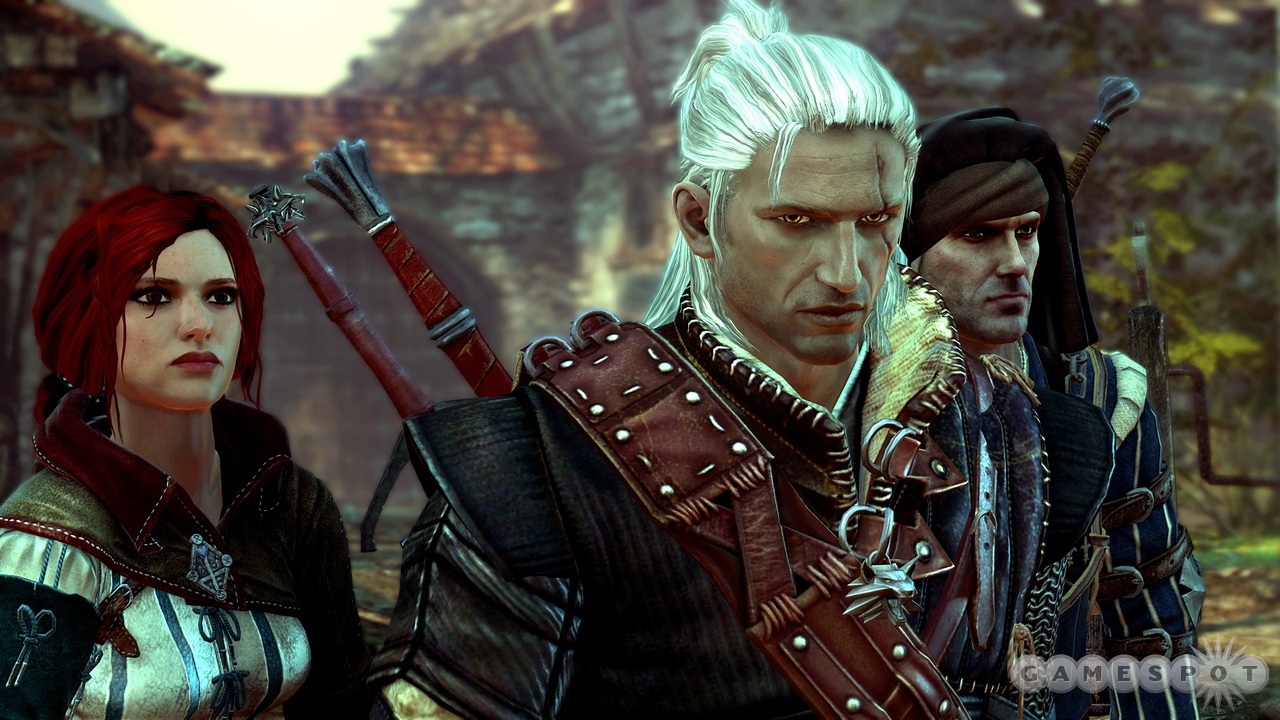
Our demonstration then switched to a playable segment of the game during which Geralt arrives at the port of the game's first major location--the medieval town of Flotsam, which lies between the borders of Temeria (Foltest's realm) and the neighboring nation of Aedim. Before disembarking from the vessel, we had the chance to listen in on banter between Geralt's two companions: Triss Merigold, the redheaded sorceress from the first game, and Vernon Roche, a sharp-tongued member of Foltest's military sent to help Geralt scout the area. We'll just say that Roche has specific opinions about a woman's proper place in the world (specifically, the kitchen) and that Triss less-than-respectfully disagrees.
After listening to some verbal jousting, Geralt breaks up the argument and leads his companions into the woods on the road to Flotsam, through thick grass and swaying, detailed brush, until the party begins to hear the sound of pipes playing. Roche makes a passing remark about "smelling" an elf nearby before leading us right into the next cinematic sequence…to meet Iorveth face-to-face. The elf casually stood atop a tree branch out of reach of Roche's and Geralt's swords. As it turns out, Iorveth and Roche know of each other--the former being aware of the latter as an elf-hating bigot, and the latter being aware of the former as a human-murdering psychopath.

In The Witcher 2, your companions don't hesitate to speak up, but like in the previous game, they're not directly under your control and will act to the best of their abilities in combat situations and will speak their minds in the game's dialogue sequences. The Witcher 2's dialogue system allows for banter between multiple participants at once, and new characters can join the conversation midway. In this particular dialogue, Roche and Iorveth continued to trade verbal barbs while Geralt quietly entered into an active dialogue with Triss about how best to attack the elf. Like the previous game, The Witcher 2 will use a "timed dialogue" system that will offer you various responses to give in conversation but will default to a standard response if you don't choose an alternate thing to say.
In this case, Geralt decided to tersely direct Triss to hurl a lightning bolt at the elf just as Roche threatened to bring our assailant in, dead or alive. Iorveth easily dodged the attack and gave a signal to a contingent of hidden elf archers to open fire, to which the quick-witted Triss responded with a powerful enchantment that enclosed the party in a protective aura of glowing orange light. While this powerful aura magically transformed any arrows it touched into harmless butterflies, it also thoroughly drained Triss, whose nose bled and eyes rolled up before she collapsed in a heap and had to be carried to safety by Roche.
Fallout 4 Next Gen Update Comparison Stellar Blade - 13 Things I Wish I Knew S.T.A.L.K.E.R. 2: Heart of Chornobyl — Official "Not a Paradise" Trailer Sea of Thieves Season 12: Official Content Update Video Manor Lords - Official Medieval City Builder/RTS Launch Trailer Devil May Cry: Peak Of Combat | Dante: Blazing Tempest Gameplay Trailer ALIEN: Rogue Incursion - Announcement Teaser Trailer Honkai: Star Rail - "Then Wake to Weep" | Version 2.2 Trailer SAND LAND — Official Launch Trailer Stellar Blade - Hard Mode No Damage Gigas Boss Gameplay Stellar Blade - Hard Mode No Damage Abaddon Boss Gameplay Stellar Blade - (Almost) All Outfits
Please enter your date of birth to view this video
By clicking 'enter', you agree to GameSpot's
Terms of Use and Privacy Policy
This ended the cutscene and pushed us into an active gameplay sequence in which we were required to follow Roche's gradual march toward the outskirts of town, fighting any elves that charged us while taking care to remain within the force field. This part of the game gave us a chance to see a very early version of The Witcher 2's combat system, which will no longer require the timed input of the original game and will instead be much more open-ended. The current, early version of the game lets you freely attack with your sword or perform an evasive roll in any direction--or smoothly transition from the former to the latter.
Though the combat system isn't finished, it currently lets Geralt dish out combination slashes with his sword by starting out with a few light slashes and then ending with a strong slash, similar to the combat systems of third-person console action games like the God of War series. However, the final version of the game will bring back different combat stances, just like in the original game, and let you mix and match various attacks from different styles freely, rather than having to manually switch styles. In any case, even the early version of combat we saw is brutal and bloody. After sending a dozen or so elves to meet their respective makers, we finally arrived at the outskirts of Flotsam, at which point Iorveth called off his archers and regrouped with the Kingslayer, who cryptically remarked that he had once ambushed Geralt while the witcher suffered from amnesia.
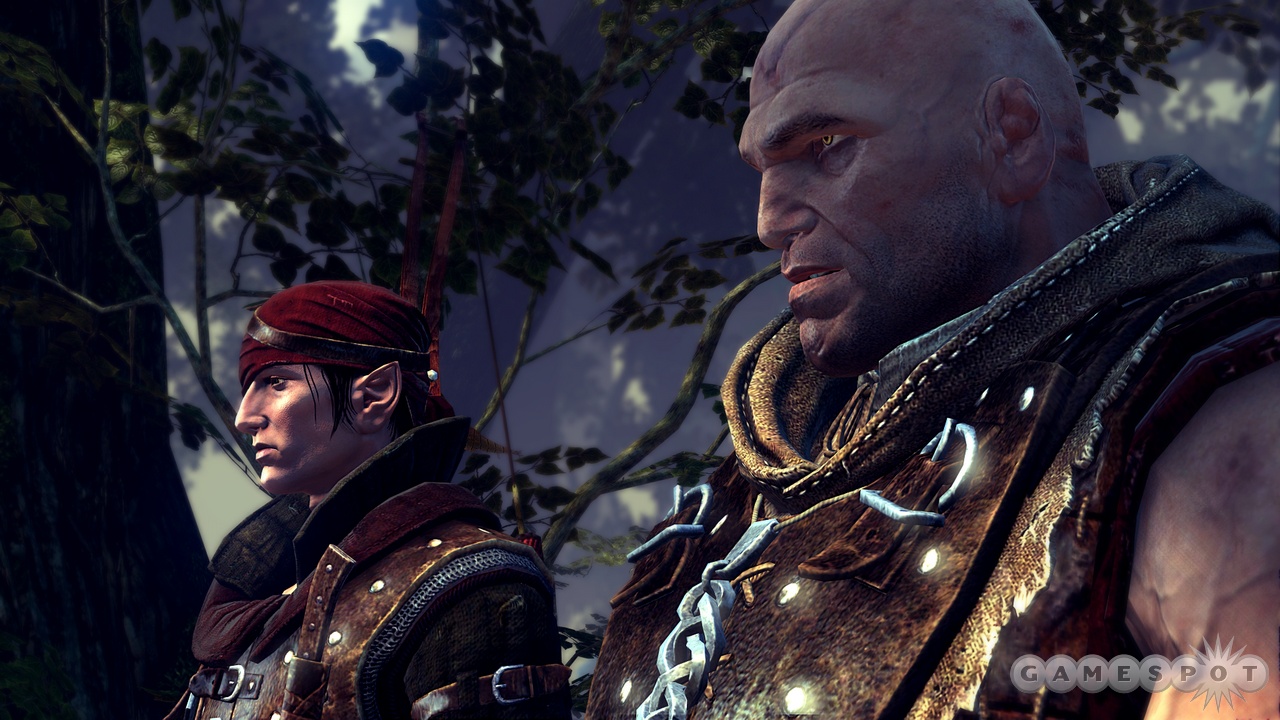
Unfortunately, Geralt didn't get a good look at his foes, and his attention was turned toward the town itself--a broken-down, grimy hamlet that could have come right out of medieval Europe. We watched the witcher make his way through the streets of the city past merchants, harlots, and other commoners (who, in the final game, will have their own ambient conversations, motivations, and potential interactions with Geralt) to reach the town square, where a public hanging was to take place.
While the hanging definitely seemed to be the highlight of the day for the otherwise miserable peasants of Flotsam, Geralt quickly realized that two of the four convicted criminals on the scaffolding were old acquaintances--his old friend Zoltan the dwarf, and his personal troubadour, the talkative human bard Dandelion. At this point, Geralt entered into a timed dialogue that gave him the choice of immediately drawing his sword and attacking the guards or trying to incite rebellion with the assembled crowds. We chose the latter option and found a vocal supporter in one of the local harlots, who strenuously protested the bard's conviction of debauchery on the grounds that debauchery wasn't a crime, but rather an enjoyable lifestyle and a good way to make a living. After a colorful, four-letter-word-laden exchange of ideas between Geralt, the audience, and the guards (which we can't recount here because this is a family site), the authorities decided they'd had enough mouthing off from the commoners and attacked anyway. We hacked a few of them to bits and even took down the hooded executioner before we were interrupted by a drawling speech from the town's burgher, who appeared from out of nowhere.
In his very public address, the burgher gave Geralt his due as a formidable witcher but subtly and skillfully reminded us that this was a wretched peasant village with no real entertainment beyond public executions. He then pointed out that two of the criminals to be hanged were elves who were guilty of arson, and he summarily executed them himself by kicking the switch, opening up the trapdoors beneath the traitors, and sending the crowds home happy. We were given the chance to try to reason with the burgher in a timed dialogue and succeeded in bargaining for the lives of Geralt's old acquaintances, and we also received a tip on a new monster that had been terrorizing the area.
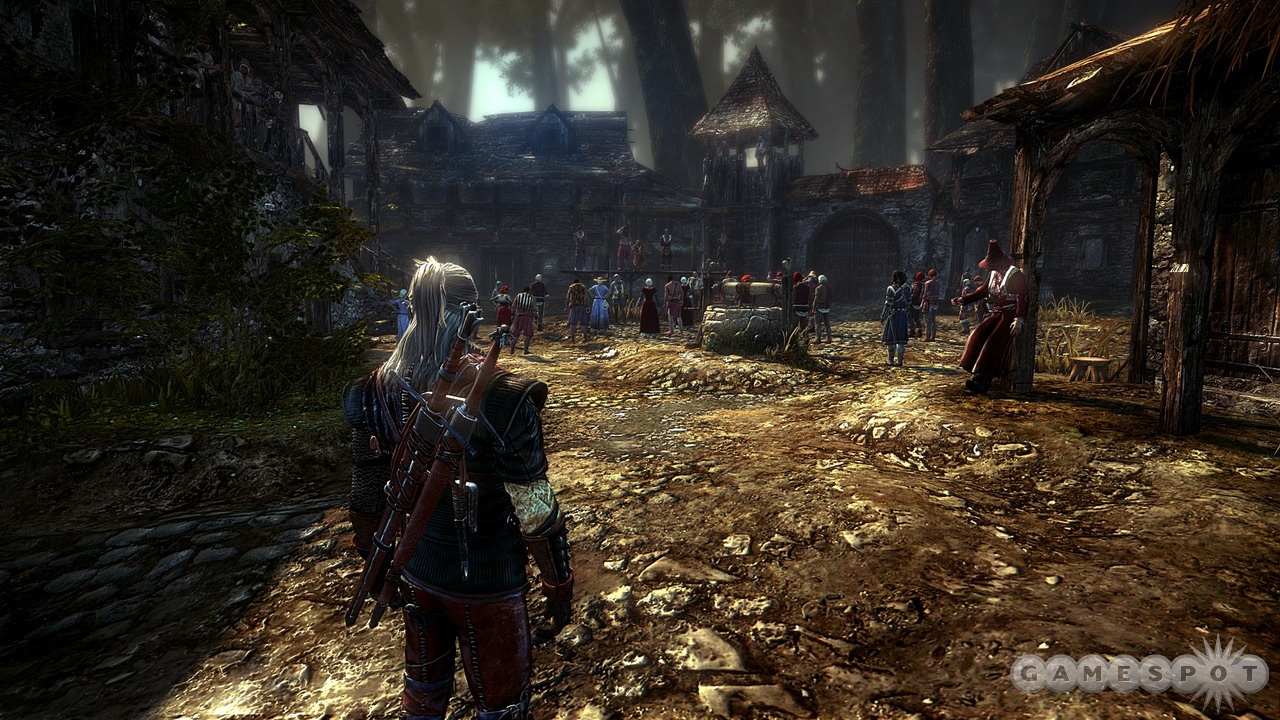
After releasing Zoltan and Dandelion, we followed them to the town's local tavern and stepped inside with zero load times--another new feature in the sequel--where the foppish bard had already busied himself gathering information and had learned the location of a nearby elven ruin. On this tip, Geralt left the tavern on his way to the area, taking the now-recovered Triss with him to investigate a possible monster lair and to "show her something later." (We'll get to what that was in just a bit.)
Geralt and Triss made their way through the forest to the ruins, fighting small groups of goblins and dispatching them easily with a combination of Geralt using swordplay and Triss flinging explosive fire-based attack spells at the enemy. The duo finally reached the ruins, a shattered stone temple overgrown by vines, and Geralt took the time to harvest a patch of elven blood roses--flowers that bloom continuously when kept in the proximity of a beating heart--and handed them to Triss as a gift while displaying his sensitive side, patiently explaining to Triss that perhaps the elves (who had been decimated and then herded into remote colonies by humans) had a right to be as angry and hostile as they were.
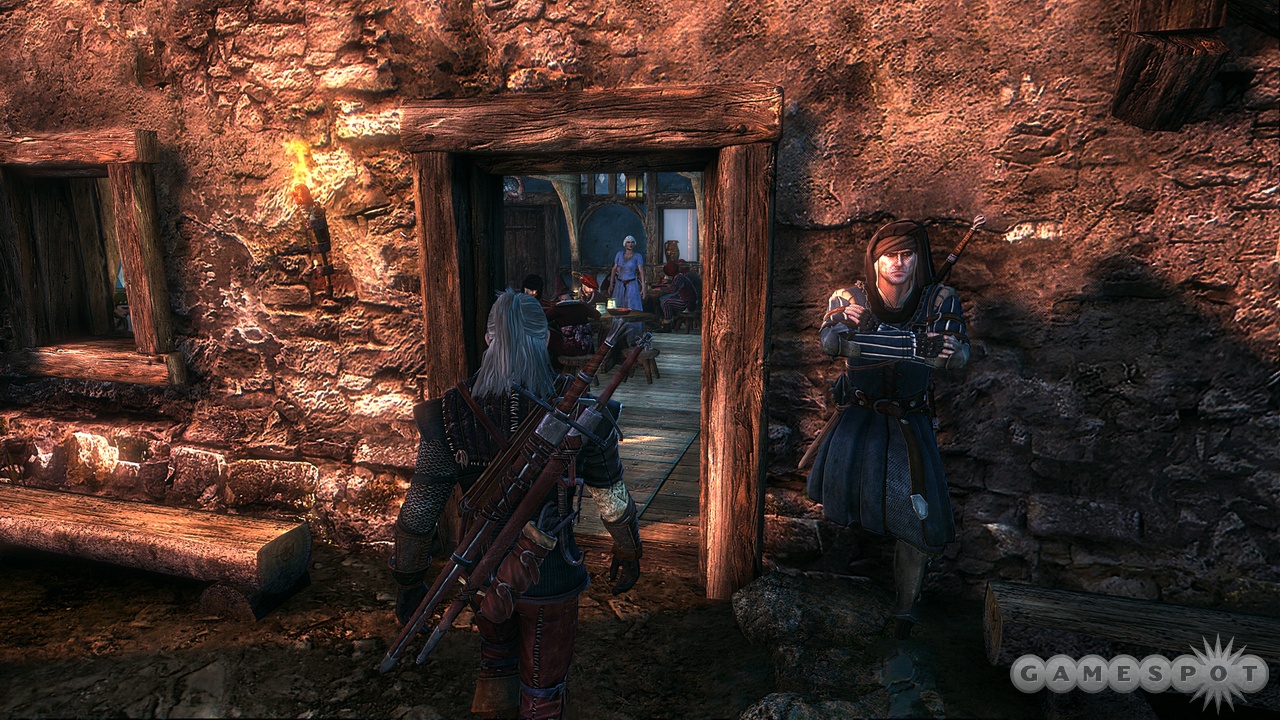
While the redheaded sorceress was clearly impressed with the gift, and possibly the sentiment, the human looters we then found in the ruins weren't exactly moved to tears. Another quick, brutal battle later, and we had dispatched most of them. The final looter lay in wait to ambush Triss, and Geralt sprang forward and gallantly leaped with her to safety, only for the two to fall through a loose cobblestone and crash-land next to the curiously preserved elven bathhouse below.
This scene set up the game's overhauled romance gameplay, which will be completely different from that of the previous game. In fact, the previous game's romance system, which rewarded you with collectible girlie cards for every woman you came to know intimately, has been scrapped. Instead, throughout The Witcher 2, Geralt can pursue relationships with various female characters through dialogue options and the occasional gift to unlock an ongoing cinematic sequence. In this case, with the two adventurers trapped in a buried elven ruin, Triss started a conversation by asking what should be done next--whether the pair should try to escape or wait to be found by their companions. Naturally, Geralt chose the option to wait.
With the extra time on their hands, one thing led to another, which led to Triss making the most unusual use of her magical powers yet--dissolving her clothes into nothing before diving into the pool. Geralt soon followed her into the water, at which point, our demonstration faded to black for reasons we hope are obvious and then faded back in sometime later. Once the game had faded back in, we were able to see The Witcher 2's new multilayer clothing system, which will let Geralt not only wear his usual black studded leather armor, but also wear armor in layers, such as carrying his weapons on an over-shoulder bandolier with a pair of light breeches, while otherwise being completely bare. Oh, and Roche then smashed through the wall and saved us.
At this point, we skipped ahead in our demonstration to a slightly later part of the game, after returning to town and accepting the burgher's quest to hunt down the town's local monster menace, a huge creature known to some as "The Old Man," but known to Geralt as a "tentadrake." This portion of the game was still very much a work-in-progress, but Geralt essentially headed to the outskirts of town and climbed ladders up to several platforms (another new feature in the sequel) to find a seedy elf arms dealer and purchase a fistful of magical Yrden traps (which, just like in the first game, will temporarily paralyze their targets when hurled at the ground), along with some explosive traps to deal with the monstrous threat.
We then skipped ahead yet again to another point deep in the forest, just outside the beast's lair. While The Witcher 2 will have open-ended gameplay and optional side quests, it turns out that slaying the mighty tentadrake is the climax of that particular early chapter of gameplay and will likely be required to advance to further chapters of the game.
The battle with the tentadrake will definitely be climactic. The giant, squidlike beast is too large to see in its entirety onscreen at once, and its giant, flailing tentacles can squash Geralt flat. Unfortunately, taking the direct approach and trying to hack away at its body or an eyeball doesn't work at the outset, since getting too close to the beast will cause it to rear its head and let out an earthshaking roar and a torrent of regurgitated seawater that will send you sprawling. Instead, you must lure one of the humongous tentacles to a Yrden trap on the ground and perform an evasive tumble when the tentacle comes crashing down. If your timing is good, you'll temporarily paralyze the creature's appendage with the trap and can then chop the limb in half by slashing it repeatedly.
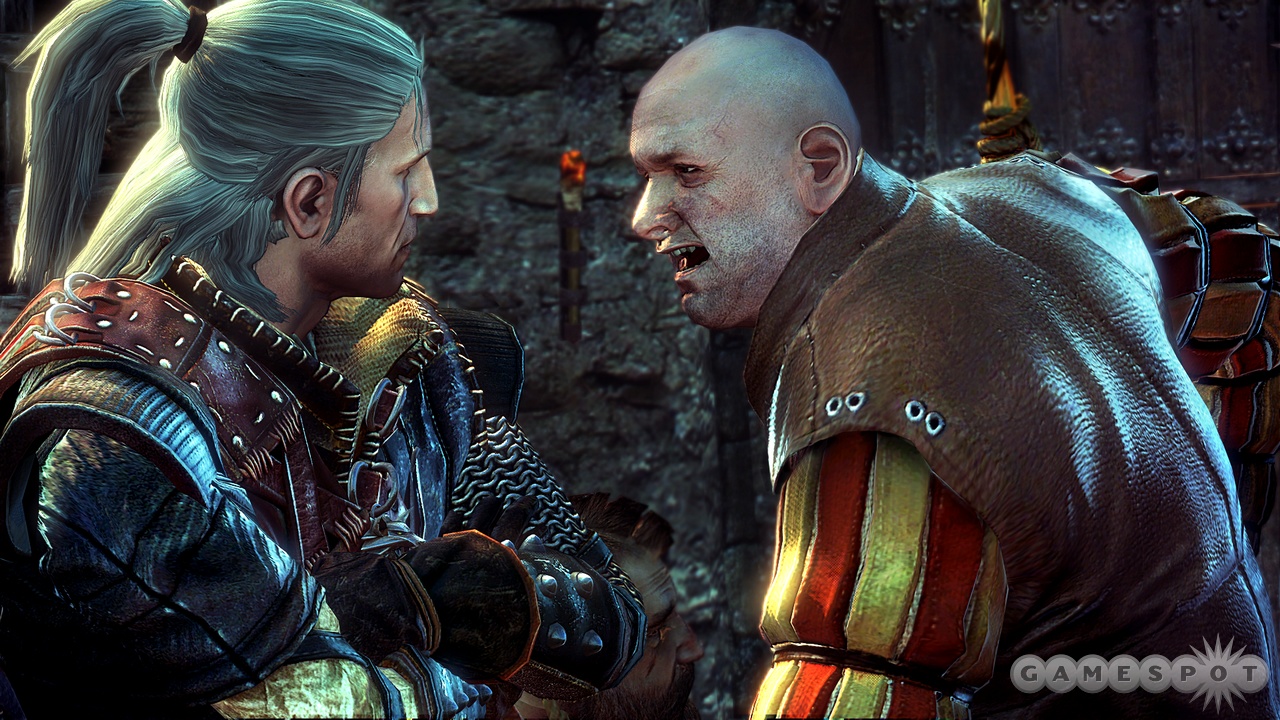
If you can relieve the creature of enough of its tentacles, you'll enrage it to the point where Geralt can actually leap aboard one of the flailing, chopped-up limbs and hang on for dear life while trying to steer it in the right direction. Specifically, if you can direct the tentacle toward a nearby stony bridge without getting thrown off, you can trick the creature into smashing out the structure's supports, causing the bridge to come crashing down on the creature's head and pinning it in place, which then lets you dash up the fallen stonework and hurl some of your explosive traps into its maw to finish it off.
Though we've seen only a brief demonstration of the sequel in motion, and although much of what we've seen is still very early in development, it's very clear that CD Projekt Red aims to produce a sequel that's far more eye-catching and more engrossing than the original game. At a glance, the new game seems a much better-looking action-role-playing hybrid with a more closely zoomed-in camera view, but it will also offer a revamped combat system, an improved character development system, and many more improvements we'll hear about in the months to come. Given that The Witcher 2 will offer a new experience with more-free-form combat, huge boss battles, and a brand-new, dark, mature fantasy story that continues after the first game left off, there's a lot for role-playing fans to be excited about. The Witcher 2 is currently planned for release in the early part of 2011 for the PC, and although CD Projekt Red is also interested in developing a console version of the game, other versions haven't been confirmed yet.
Got a news tip or want to contact us directly? Email news@gamespot.com
Join the conversation